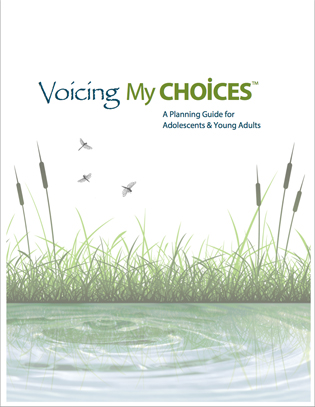New Methods
“Voicing My Choices”: Terminally Ill Teens and Young Adults Express Their Wishes

More than 11,000 adolescents and young adults (AYAs; 15 to 34 years old) die each year from cancer and other terminal illnesses. But they usually are not involved in planning their own end-of-life (EOL) care. Decisions are often left up to grief-stricken parents who have no idea what their children want. And the AYAs are afraid of hurting their parents, so they may refrain from expressing their wishes.
NIH researchers have developed an age-appropriate advance-care planning guide, “Voicing My Choices,” that aims to open communications with terminally ill teenagers and young adults. The guide was developed by staff scientist and social worker Lori Wiener (National Cancer Institute, NCI), pediatric psychologist Sima Zadeh (NCI), and child and adolescent psychiatrist Maryland Pao (National Institute of Mental Health). It was the culmination of a two-phase study with cancer- or HIV-positive AYAs (Pediatrics 130:897–905, 2012).
In the second phase of the study, the researchers assessed the usefulness of two advance-care planning guides: “Five Wishes,” which is geared to older patients, and “My Thoughts, My Wishes, My Voice,” a modified guide geared to young people based on what was learned through focus groups in an earlier phase of the NCI study. Randomly ordered pages from the two guides were presented to 52 AYA volunteers who had metastatic or recurrent cancer or human immunodeficiency virus (HIV) infection (acquired at birth or early in life). The participants were asked to rank 25 items based on several factors.
The study found that AYAs with life-threatening illnesses want to be able to determine the kind of life-support treatment they do and don’t want; how they would like to be cared for; information they’d like their family and friends to know, and how they would like to be remembered. Crucially, AYAs displayed something both Wiener and Pao had long believed to be true: The AYAs thought about EOL decisions and were prepared to have conversations about care and treatment options.
Following the second phase of the study, the researchers used the qualitative and quantitative data from the AYAs to design the planning guide, “Voicing My Choices.” It’s a tool that helps providers “find the words to talk about the patients’ preferences for their care should they become very ill,” said Pao. Whether presented in its entirety or one page at a time, the guide is meant to be a way to break down the discomfort that surrounds the discussion of EOL topics.
We gave “providers the language with which they could address these hard questions,” said Pao. We “are trying to bring these discussions to the forefront of EOL decision-making by including AYAs in a discussion they have long had very little input in.”
Since it was introduced in 2012, more than 26,000 copies of the guide have been ordered, and it has been translated into Spanish, Italian, French, and Slovak.
The researchers recently published another paper that provides advice on how health-care providers can effectively use the “Voicing My Choices” guide when attempting to engage in EOL discussions (Palliat Support Care, 13:591–599, 2015). The paper offers “guidelines on how to: incorporate EOL planning into the practice setting, identify time points at which a patient’s goals of care are discussed, and address how to empower the patient and incorporate the family in EOL planning.”
Finally, AYAs and their families have a way to break the silence around the most painful of topics—death.
To download a copy of the “Voicing My Choices” guide, go to https://www.agingwithdignity.org/voicing-my-choices.php
NEW METHODS
The NIH Catalyst is always looking for stories about new methods that have been developed by NIH researchers. If you developed a method within the past year—or you know of someone who did—please contact the editors at catalyst@nih.gov or 301-402-1449 to see if we might feature it on these pages.
This page was last updated on Monday, April 25, 2022
